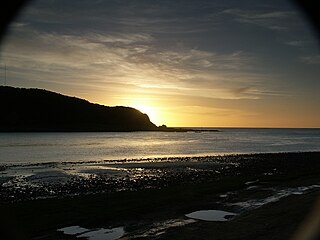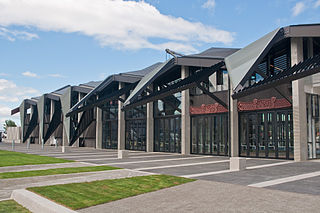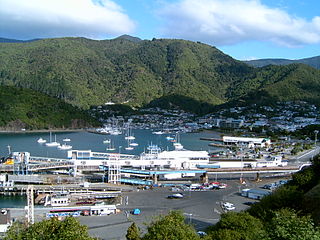
Ngāti Toa, Ngāti Toarangatira or Ngāti Toa Rangatira, is a Māori iwi (tribe) in the lower North Island and upper South Island of New Zealand. Its rohe extends from Whanganui in the north, Palmerston North in the east, and Kaikoura and Hokitika in the south. Ngāti Toa remains a small iwi with a population of only about 4500. It has four marae: Takapūwāhia and Hongoeka in Porirua, and Whakatū and Wairau in the north of the South Island. Ngāti Toa's governing body has the name Te Rūnanga o Toa Rangatira.

Pōtatau Te Wherowhero was a Māori warrior, leader of the Waikato iwi (tribes), the first Māori King and founder of the Te Wherowhero royal dynasty. He was first known just as Te Wherowhero and took the name Pōtatau after he became king in 1858. As disputes over land grew more severe Te Wherowhero found himself increasingly at odds with the Government and its policies.
Te Pīhopatanga o Te Waipounamu is an episcopal polity of the Anglican Church in Aotearoa, New Zealand and Polynesia. Te Pīhopatanga encompasses the South Island of New Zealand in its entirety and also Stewart Island/Rakiura and the Chatham Islands. According to the 2001 census there are approximately 15,000 Māori Anglicans within this area. Te Waipounamu is one of five pīhopatanga that comprise Te Pīhopatanga o Aotearoa, the Māori Anglican Church in Aotearoa/New Zealand.

Ngāti Koata or Ngāti Kōata is a Māori iwi of New Zealand, originating on the west coast of Waikato, but now mainly at the northern tip of South Island.
Ngāti Kuia is a Māori iwi of the Northern South Island in New Zealand. They first settled in the Pelorus Sound, and later spread to the Marlborough Sounds, Nelson and Tasman districts to Taitapu on the West Coast, and as far south as the Nelson Lakes National Park. Ngāti Kuia tradition states that their founding tupuna Matua Hautere, a descendant of Kupe, came to Te Waipounamu in his waka Te Hoiere, guided by the kaitiaki Kaikaiawaro.
Ngāti Rārua are descendants of the Polynesian explorers who arrived in Aotearoa aboard the waka (canoe) Tainui.

For the ship see RMS Rangitane
In Māori tradition, Te Kōhatuwhenua was one of the great ocean-going, voyaging canoes that was used in the migrations that settled New Zealand. Taranaki iwi Ngāti Ruanui and Ngā Rauru trace their ancestry back to Taikehu, the captain of Te Kōhatuwhenua.
In Māori tradition, Te Rangiuamutu was one of the great ocean-going, voyaging canoes that was used in the migrations that settled New Zealand. Taranaki iwi Ngāti Ruanui and Ngā Rauru link their ancestry to Tamatearokai the captain of Te Rangiuamutu.

Te Matatini is a national Māori performing arts festival in which kapa haka performers from all around Aotearoa compete in the Te Matatini festival. The name was given by Professor Wharehuia Milroy, a composite of Te Mata meaning the face and tini denoting many — hence the meaning of Te Matatini is many faces.

Ngāti Maru is a Māori iwi of inland Taranaki in New Zealand. They are descended from Maruwharanui, the eldest son of Pito Haranui and his wife, Manauea. Pito Haranui belonged to an ancient Taranaki people known as the Kahui-Maru, whose genealogy predates the arrival of Toi.
Atawhai is one of the suburbs of Nelson, New Zealand. It lies north of Nelson and is the location of Wakapuaka Cemetery, a burial place since 1861. It also has a coastline on Nelson Haven and access to Boulder Bank from State Highway 6.
The history of the Nelson Region of New Zealand dates back to settlement by the Māori people in about the 12th century. The Nelson and Marlborough Region were known to the Māori as Te Tau Ihu o Te Waka a Maui which means "The Prow of the Canoe of Maui".

Te Raukura, otherwise known as Te Wharewaka o Poneke is a building located on Taranaki Street Wharf, Wellington waterfront, New Zealand. It houses a conference venue, Karaka Cafe, and waka house.
Te Atiawa o Te Waka-a-Māui is a Māori iwi (tribe) in the upper South Island of New Zealand. Its rohe extends from Golden Bay and Marlborough Sounds at the top of the South Island to Cape Campbell, St Arnaud and Westport.

Te Tau Ihu Māori are a group of Māori iwi in the upper South Island of New Zealand. It includes Ngāti Kuia, Rangitāne and Ngāti Apa, Ngāti Koata, Ngāti Rārua and Ngāti Toa, and Ngāti Tama and Te Āti Awa.
Waipounamu Māori are a group of Māori iwi at or around the South Island of New Zealand. It includes the iwi (tribe) of Ngāi Tahu and the historical iwi of Kāti Māmoe, who occupy the island except for its most northern districts. It also includes Te Tau Ihu Māori iwi, such as Ngāti Toa, Te Atiawa o Te Waka-a-Māui, Ngāti Apa ki te Rā Tō, Rangitāne, Ngāti Kuia, Ngāti Rārua, Ngāti Kōata and Ngāti Tama.
The Māori people and Moriori people have hundreds of marae around New Zealand.




















